Minnie Berrington -Andamooka's First Postmistress
4 October 2018 by Johno
Categories: Opal Fields Characters | Opal Fields | Australian Opal
A short time after I had published the story of Minnie Berrington I was contacted by Stuart Wattison who had carried out a lot of research into Minnies life. He had dug up copies of certificates including her Miners Right and this has added authentication of her story as told in her book "Stones of Fire". Stuart has now written her story and has kindly agreed to let me publish it on this website. The following is her story as written by Stuart Wattison.
Minnie Berrington - Andamooka's First Postmistress
by Stuart Wattison, ACCCF
First published in the Philatelic Society of South Australia Inc. journals: The Shilling Violet No. 78 August 2018 and Stamp Talk Vol. 44 No. 2 (Whole No. 167) August 2018
During the 1990s my wife, Terry, and I spent a few days in Coober Pedy and, among other things, visited the Old Timers Mine. In this tourist attraction were several mannequins representing early miners. One of these was Minnie Berrington, the first female opal miner in Coober Pedy (see Note 1). The significance of this did not emerge until later. During a period while I was working on a fly-in / fly-out basis at remote sites in Queensland and Western Australia, Terry took a part time job looking after old folks and disabled people. One of her clients was called Minnie Berrington. I met her only once. She was then 101 years old, very frail and with failing eyesight but still mentally sharp. During our conversation she revealed that she was the Minnie Berrington represented in the Old Timers Mine and had written a book 1 describing her experiences in Coober Pedy and later in Andamooka. Despite her small stature (see note 2) she sank her own mine shafts with a pick and shovel but was later introduced to the use of gelignite then very much considered a man's job.
Alice Minnie Florence Davies-Berrington was born in Birkenhead, Cheshire, England on 9th October 1897 6 (see Note 3), the second of four children and only daughter of Evelyn Delahaye Davies-Berrington and Eleanor Ann Davies-Berrington (ne?e Wittington).
Below is a Portrait of Minnie Berrington by Emil Otto Hoppe? 1930 2.

Portrait of Minnie Berrington
SS Bendigo (1922 - 1936) in 1928.

The SS Bendigo on which Minnie Berrington arrived in Australia
Her ancestry can be traced back to the Plantagenet kings of England, 1154 - 1485 3. Prior to her trip down under she worked in London as a domestic servant and as a shorthand typist before that 4. Wishing to improve her situation she set sail from Tilbury with her youngest brother, Victor, on 17th December 1925 on the SS Bendigo, arriving in Adelaide on 3rd February 1926 8 (see note 4). She traveled under an Assisted Passage Scheme for domestic helpers and took a pre-arranged job in Kingswood with "Mrs. O. Hyman" 4, the wife of Australian Rules football player Oscar Henric Hyman 1877 - 1955 5, on her arrival. Victor soon joined a group of bush traders. In spite of signing, prior to leaving England, an "Undertaking To Engage In Domestic Duties In Australia" for at least twelve months 4, Victor's enthusiastic letters to Minnie encouraged her to travel north. In June 1926 she boarded the Afghan Express (The Ghan) to William Creek. She was quite overwhelmed by the outback, describing the spectacle of sunrise between Beltana and Marree in her book as follows:
"The enchantment of that golden serenity was so complete that I knew that I'd never willingly live in the city again."
At William Creek she was met by Victor and the supplies van which took her via bush tracks to Coober Pedy. The search for opal commenced and she and Victor built a bough shed which they called Bush House 1, after the large building with the same name in London and probably also because of its setting. This soon proved to provide insufficient protection against the infrequent rain so they moved to "Turley's" dugout, the first of several, which offered better protection against both the rain and the scorching summer sun. She was soon struck by "opal fever" (see note 5). Her income from mining was supplemented by working as a shop assistant at Jacob Santing's store 3 (see note 6). She also learned to drive, by her own account a rather hair-raising experience for her instructor (Not so fast, not so fast), and acquired a two-seater car, with a partly dismantled dicky seat at the back and popularly known as The Red Terror 1, so could deliver stores to those who did not have their own vehicles.
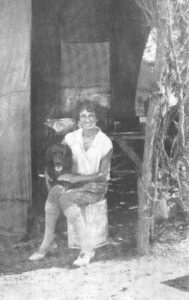
Minnie Berrington and dog Taff
"Myself and Taff outside bough shed Roger and I built" from Stones of Fire.
In the early 1930s there was a persistent rumour of a new opal field "near Pimba" but this was largely disregarded. When Minnie returned from a few weeks holiday over the 1933 Christmas period (see note 7) she found new interest in this rumour. A knowledgeable interstate opal buyer, probably Ernie Sherman 10, who had bought a parcel of opal from South Australia declared that it did not come from Coober Pedy. This and memories of an occasional buyer saying that he had once purchased a parcel of opal on a sheep station called Andamooka prompted plans to be made for a move and about a week later she set off by road in convoy (see Note 8) on the more than 350 mile (560km) trip via Kingoonya and Pimba (see note 9). She now became the first female opal miner in Andamooka and was a driving force in the development of the opal field 10. While she was a successful opal miner including finding some of the prized black opal 1 she undertook a variety of jobs including driver, general store assistant, police agent and census taker. The items which refer to her activities in Andamooka, can be found in the opal museum below the Andamooka Post Office.
In August 1942 she enlisted in the Australian Women's Army Service, which was formed a year earlier in order to release men from administrative duties for redeployment to fighting units 16, and was stationed at 6 Australian Base Ordnance Depot, Torrens Hall, Adelaide 17. She fibbed about her age to enhance her chances of enlistment. Her pay record shows her age as 41, not 44 years and 10 months, and date of birth as 9th October 1900 even though the maximum age of enlistment in the A.W.A.S. was 4516. In September 1942 she was transferred to 3 Australian Central Ordnance Depot (probably at Keswick) where she worked as a typist and later as a clerk 18. Her Staff Sergeant was so pleased with her work that he sent her a note, dated 22nd May 1943, which reads:
"Your devotion to duty, & good work has been an inspiration to this section. I do thank you most sincerely for all you have done for me." 19
With the exception of a period in July and August 1943 when she attended 5 AWAS NCO School, she remained at 3 ACOD until March 1945. She was then transferred back to 6 ABOD where she received her promotion to Corporal on 4th January 1946. When she was discharged in February 1946 she returned to Andamooka to continue her prospecting activities.
In the early days of the opal field, the mail was brought from Pimba only as far as the Andamooka Station Homestead 12. From there it was brought the 30 miles to the opal field by a person who was paid one shilling a week by the residents 12 to make the trip. In mid-1940 the mail contractor offered to extend the service to the opal field. By 1946 the population had grown sufficiently for E.H.D. Russell, the member for the electorate of Grey, to make representations to H. H. Miethke, the Acting Deputy Director of Posts and Telegraphs regarding the establishment of a Post Office. This was agreed and the non-official Andamooka Opal Fields Post Office (renamed Andamooka 2nd July 1990 21) opened on 13th January 1947 with Minnie as the first Postmistress 20.
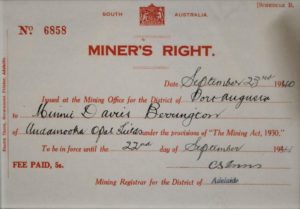
Miner's Right dated 23rd September 1940.
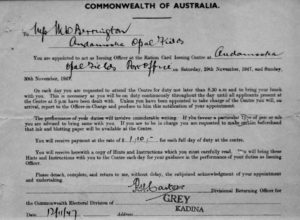
Ration Card Issuing Officer Certificate dated 12th November 1947.
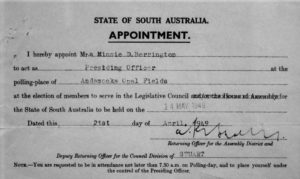
SA Legislative Council Election Presiding Officer Certificate dated 21st April 1949.
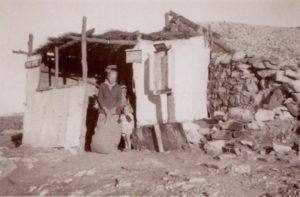
Minnie Berrington and Post bag
Minnie with mailbag outside Andamooka Opal Fields Post Office c. 1948 - courtesy Lorna Cameron.
In addition to handling the mail, this office sold Postage Stamps, related items and Postal Notes but provided no Money Order, Telephone or Telegraph facilities 22. About a year later Old-Age Pension Payment facilities were added. Opening hours were 9am to 10am and 3:30pm to 4:30pm, except Sundays. In April 1947 Minnie requested an arrangement for issuing Miners' Rights. In due course this was accepted and issues commenced in June 1947 11, 13. A separate Telegraph office was opened in December 1948 and the radio-telephone was installed in the dugout (home) of Sam and Rose Brooks. Rose was the operator until it became too onerous for her to handle and it was transferred to the non-official Post Office in May 1965 after Minnie had left Andamooka 21. Minnie remained Postmistress until late 1949 and finally left Andamooka for health reasons in late 1951 or early 1952 (see note 10).
During the next six years she lived in the Adelaide suburb of Goodwood and worked as a typist 24, 25. It must have been during this period that ?Stones of Fire? was written. The typed manuscript was completed in 1956 26 and following editing work with the publisher Minnie traveled overseas in 1957, disembarking on her return at Fremantle on 17th October 1957 27.
In late 1961 or early 1962 she moved to a stone cottage purchased jointly with Victor in Quorn 29, 30 while Victor worked as a mechanic at the coal mining town of Leigh Creek 28. About two years later Victor joined her and worked as a radio mechanic 30 until he died suddenly on 4th March 1965 31. In 1966 she traveled overseas again. Returning from London, she arrived in Adelaide on 27th October 32 and, after a short stay in Glenelg 33 she moved to Magill 34, an eastern suburb of Adelaide. This remained her home for the rest of her life 35, 36, 37. She died on Friday, 13th April 2001 38 at the age of 103 (see note 11) and her ashes are buried at Quorn with her brother, Victor.

Minnie Berrington's Grave
Minnie's and Victor's final resting place at plot 86 in the Quorn cemetery. The small plaque reads: "ALICE M. F. BERRINGTON / DIED 13. 4. 2001 / AGED 103 YEARS / AT REST".
Framed Memorial Scroll in Opal Museum below Andamooka Post Office. (Adapted from Minnie's Funeral Memorial Card)
Minnie was a truly remarkable lady who never married and has a place in the postal history of South Australia. Reading "Stones of Fire" is recommended even for those without a strong interest in opal and opal mining. It is out of print but copies can be found on the Internet.
I wish to thank members of the staff of the State Library of South Australia, South Australian Archives Research Centre and the National Archives of Australia (Adelaide and Canberra), members of the SA Study Group of the Philatelic Society of South Australia, Sue Britt (Treasurer of the Coober Pedy Historical Society), Angie Finlay (Flinders Ranges Council), Lorna Cameron and others who have assisted with the gathering of information for this article.
Notes:
- The sign on the mannequin needs to be taken at face value and reads:MINNIE BERRINGTONTHE FIRST WOMAN TO MINE HER OWN CLAIM IN 1925.The date is not correct and Mary Halliday, who was the recipient of Miners' Right No. 7459 dated 26th October 1921 15, is a legitimate claimant of the first female opal miner title. A Mrs. Pearce (spelling in doubt and also possibly not her real name) is believed to have received a Miners' Right about the same time. Minnie did not have a Miners' Right in her own name until April 1930 15.
- Minnie's pre-immigration medical report 4 dated 15th September 1925 records her height and weight as 5ft 2in (157cm) and 8st 2lb (52kg) respectively.
- Reference 6, now corrected, recorded her date of birth as 23rd October 1897 obtained from an entry, dated 7th November 1897, in the Baptism Register of the Church of The Holy Trinity, Birkenhead. Her birth certificate and an Incoming passenger card NAA: A1197 Barcode 12182950 signed by Minnie show her date of birth as 9th October 1897.
- Reference 3 records the date of arrival as 25th January 1926. The SS Bendigo (7925 nett tonnage) was in Fremantle on that date 8.
- Minnie was the "girl-digger" referred to by Emil Hoppe? in reference 9.
- Santing is the "Joseph Holland" referenced in Stones of Fire. He was Dutch. The photograph on page 142 in reference 2 shows "J. Santing" as the store owner. She also refers to her brother as "Roger". According to reference 10 pseudonyms are used throughout Minnie?s book.
- Reference 15 shows that the Miners' Right numbered 5845 was issued to Minnie on 3rd April 1933. Reference 11 shows that this number came from a book in use in Coober Pedy. Reference 14 shows that she was living in Andamooka by July 1934. It follows that she was referring to Christmas 1933 on page 125 of reference 1. Further, Miners' Right 4326, issued to Minnie on 26th February 1934, is not recorded in reference 11 as being issued from Coober Pedy or Port Augusta, the nearest issuing point to Andamooka. It is therefore likely that this and later Rights until June 1947 were supplied by post directly from the Department of Mines in Adelaide and that she was already in Andamooka by mid- February 1934. C.S. Inns whose signature appears on the Miners' Right number 6858 illustrated in this article was the Registrar of Mines.
- In reference 1 Minnie calls her companions Mac, Frank Woodlock and Northvale (all pseudonyms). Various sources identify two of these as William (Bill) Hallion and George James Malycha. The third was possibly Francis (Frank) Albertoni. Sources stating that Albertoni arrived in Andamooka in 1931 cannot be correct. All three purchased Miners? Rights(numbers 5844, 5837 and5849 respectively) in 1933from the same Coober Pedybook as Minnie and, likeMinnie, purchased Miners' Rights (numbers 4325, 6211 and 4769 respectively) in 1934 from another source, probably Adelaide by post. It is possible that "Northvale" was Alfred John North but further research is required to be confident about the identities of Minnie's companions.
- I traveled the road from Pimba to Andamooka in June 1972. The road was well defined but still dirt then and gibber strewn in many places. When I arrived in Andamooka rain began to fall so, after having some lunch, I set off on my return journey. The road was very slippery and by the time I reached Woomera one tyre had been wrecked and the wheel arches of my car were completely filled with mud. Some time later I discovered that a friend who was working at the Island Lagoon Deep Space tracking station (DSS41) and was at his claim at White Dam, about 10km from Andamooka, starting the same journey about two hours later and had considerable difficulty in a short wheel-based Landrover. The road from Pimba to Coober Pedy via Kingoonya was not much better. The condition of the road in the 1930s hardly bears thinking about!
- According to anecdotal evidence attributed to Mary Wiley, Minnie's long-term friend and next-door neighbour in Magill, Minnie said that she left Andamooka for health reasons in 1949. It appears that this should be interpreted as resigning from the Postmistress position in 1949. Reference 18 shows that she was transferred to Military Hospital on two occasions in the last quarter of 1945. One of these included admission to the Royal Adelaide Hospital. Reference 23 shows that she was again admitted into the RAH on 3rd March 1948 (Beatrice Ward), discharged on 11th March and that her occupation was Postmistress. Reference 11 records that R.S. (Dick) Clark was the issuer of Miners' Rights from 1st December 1949. It appears that Minnie's resignation took effect from this date. Unfortunately the associated docket (D.M. 758/49) is not held in State Records of South Australia. During a telephone conversation with Lorna Cameron, a daughter of Sam Brooks, one of the discoverers of opal at Andamooka, she stated that when she left Andamooka in 1951 Minnie was still there. The Electoral Roll for 1950, which closed on 2nd October 1950, still shows her occupation as Postmistress but this would not affect her voting entitlement. However, the Electoral Roll for 1952, which closed on 6th October 1952, shows that she was then living in Goodwood and her occupation was typist.
- The death notice in The Advertiser shows her date of death as 13th April 2000 38. Blackwell Funerals in Torrensville confirm that this is a typo. She died in 2001 and is buried with her brother.
- In the references below: NAA is National Archives of Australia and SLSA is State Library of South Australia.
References:
- STONES OF FIRE A Woman's Experiences in Search of Opal by M.D. Berrington published byRobertson & Mullens Ltd., Melbourne July 1958.
- E.O.Hoppers Australia edited by Graham Howe, published by W.W. Norton & Company, New York &London 2007.
- Web site http://oztypewriter.blogspot.com.au/2016/06/from-london-typist-to-opal-miner-in.html
- Assisted Passage for Domestic Helpers file GRG7 Folio No. 614 in State Records of South Australia.
- Web Site https://en.wikipedia.org/wiki/Oscar_Hyman
- Web site http://wyndhammarsh.co.uk/genealogy/getperson.php?personID=I12153&tree=CledwynMarsh
- Web site http://www.johnosopals.com/2014/04/andamooka-opal-field-update-minnie-berrington#more-1320
- Passenger List of SS Bendigo voyage from London to Sydney 1925 - 1926GRG_41_34_0_251-1926_Bendigo.pdf in State Records of South Australia.
- The Fifth Continent by E.O. Hoppe? published by Simkin Marshall Ltd, 1931.
- A Journey with Colour: The History of Opal in South Australia by Len Cram, Self-published 2006.
- Returns from Issues of Miners' Rights GRG30/14/0001 in State Records of South Australia.
- Andamooka Then & Now published by Andamooka Area School 1980.
- Correspondence Dockets GRS/6038 Folio 515/47 in State Records of South Australia.
- Electoral Roll for South Australia/Grey/Flinders/Whyalla which closed 2nd July 1934 (SLSA).
- Register of Miners' Rights GRG30/13/0000 in State Records of South Australia.
- Web site https://en.wikipedia.org/wiki/Australian_Women%27s_Army_Service
- Pay Record File - Minnie Berrington NAA: D1357: SF65196.
- Service Record - Minnie Berrington NAA: B884: SF65196.
- Item in the Coober Pedy Historical Society collection BI 00034 8.
- The Advertiser, Adelaide Thursday 9th January 1947 (Trove).The Transcontinental, Port Augusta Friday 10th January 1947 (Trove).
- The Post, Telegraph and Telephone Offices of South Australia and the Northern Territory by Martin Walker,Self published 2004.
- Commonwealth Post Office Guide 1946 (updated) NAA: D5286: 1946 andCommonwealth Post Office Guide 1948 NAA: D5286: 1948
- Alphabetical index to register of patients - Adelaide Hospital, later Royal Adelaide HospitalGRG78/46/00000/17 in State Records of South Australia.
- Electoral Roll for South Australia/Kingston/Goodwood/Goodwood 1952 and 1954 (SLSA)
- Electoral Roll for South Australia/Boothby/Unley/Goodwood 1955 and 1958 (SLSA)
- Typed manuscript of Stones Of Fire, originally titled Dally In Wonderland, by M.D. Berrington dated 1956D5394 [Lit. Ms.] held by the State Library of South Australia. Donated by Minnie February 1972.
- Passenger List of SS Iberia voyage from London to Sydney 1957 NAA: K269 Barcode 301321196.
- Electoral Roll for South Australia/Grey/Frome/Beltana 1961 and 1962 (SLSA).
- Assessment Books for District Council of Kanyaka (Suburban Ward) 1962 to 1966 held by Flinders RangesCouncil.
- Electoral Roll for South Australia/Grey/Frome/Carrieton 1963, 1964, 1965 and 1966 (SLSA).
- The Advertiser, Adelaide Friday 5th March 1965 (SLSA).
- Passenger List of SS Himalaya voyage from London to Sydney 1966 NAA: K269 7092051.
- Electoral Roll for South Australia/Kingston/Glenelg/Glenelg 1967 (SLSA).
- Electoral Roll for South Australia/Sturt/Burnside/Magill 1968 and 1969 (SLSA).
- Electoral Roll for South Australia/Sturt/Coles/Coles 1970, 1971, 1972, 1973, 1974, 1975 and 1977(1) (SLSA).
- Electoral Roll for South Australia/Sturt/Hartley/Hartley 1977, 1979, 1980, 1982, 1983, 1984 and 1985 (SLSA).
- Electoral Roll for South Australia/Sturt 1989 to 2001(1) (SLSA).
- The Advertiser, Adelaide Tuesday 17th April 2001 (SLSA).
Thank you very much Stuart for this well documented account of Minnie's life.
Stuart has now advised me that his article is now available at the South Australian library. You can view it in a better format on Minnies Life.
Johno